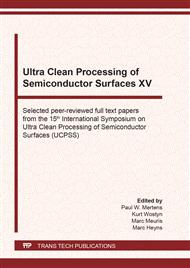p.9
p.17
p.23
p.29
p.34
p.41
p.49
p.54
p.60
Experimental Wafer Carrier Contamination Analysis and Monitoring in Fully Automated 300 mm Power Production Lines
Abstract:
Contamination control is essential in semiconductor manufacturing to ensure high yield and product quality. Latest power electronic devices are manufactured in fully automated 300 mm production lines, which utilize closed wafer containers called Front Opening Unified Pods (FOUPs). It has been observed, that FOUPs capture airborne molecular contaminants (AMC) outgassing from processed wafers or being transferred from the equipment minienvironment. These AMC might be released afterwards and can lead to defects causing yield and/or reliability issues of the power devices. Specific FOUP cleaning and exchange rules are already being utilized in the fab. But so far, these rules are not validated or adapted by actual concentration values in the FOUPs. In this paper, contamination levels in FOUPs are investigated to identify the sources of different AMC. The contamination data is analysed together with FOUP logistics data in order to establish an optimized FOUP management strategy. In the first part, in-line carrier contamination control is explained and a general overview of the AMC detected is given. In the second part, the data-driven FOUP-monitoring is described using the example of the root cause analysis of hydrofluoric acid (HF) contamination.
Info:
Periodical:
Pages:
34-40
Citation:
Online since:
February 2021
Authors:
Permissions:
Share:
Citation:


